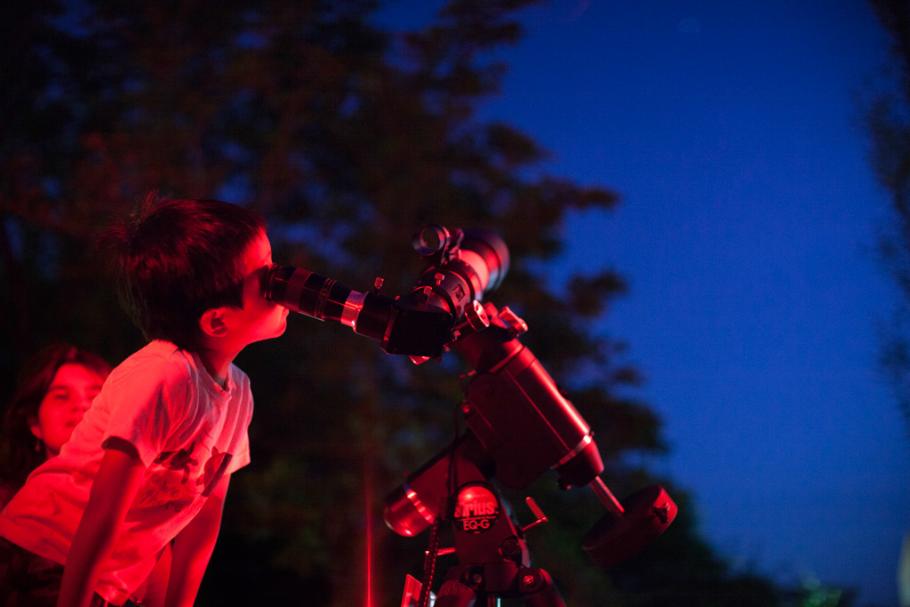One of the most common questions we get at the Phoebe Waterman Haas Public Observatory is about what kind of telescope to buy, whether for a gift or for personal use. We’re here to help answer that question.
First, are you a novice sky gazer? In that case, don’t buy a telescope just yet! Telescopes are a useful tool, but they do not teach you the night sky. Often, they can be frustrating if you get one before you’re ready. We recommend starting with a sky map to build some familiarity. Learn a few constellations, watch for the Moon's changing phases, and find a planet if any are visible. Try our Neighborhood Stonehenge activity to help you get your bearings. Another great resource is your local observatory or amateur astronomy club. They likely have regular stargazing events, which are an ideal time to try out different telescopes and ask advice from knowledgeable and enthusiastic people.
Binoculars can be a good “first telescope.” They are portable and can reveal surprising detail on the Moon and planets. In fact, many celestial sights like comets and star clusters actually look better with binoculars than with a telescope! The numbers on the binoculars will tell you the magnification and the size of the lenses. For example, a 10x50 pair of binoculars has 10x magnification and lenses 50mm in diameter. Look for high optical quality, magnifications between 7x and 10x, and lenses at least 35mm in diameter.
If you’re feeling ready for a telescope, do your research. Online reviews and local astronomers are a great source of information. There is no “best” telescope out there; the right one for you is the one that you will actually use! Here is some general guidance:
- Consider your budget, what sky objects you want to view, and where you will use your telescope (home? local park? traveling?) before making a purchase. Whatever telescope you get should serve your particular needs.
- Most telescopes that cost less than $150 will have low optical quality and aren't really worth it. We suggest getting good binoculars instead.
- Stay away from any telescope advertised for its magnifying power.
- A telescope’s most important attribute is its size, meaning the diameter of its main mirror or lens. The bigger the telescope, the more light it collects, which allows you to see fainter objects. You can observe quite a lot with a telescope just 4 to 6 inches diameter.
- For a child, look for a tabletop telescope that’s portable, easy to aim at different things, and virtually indestructible.
- A popular first telescope is a Dobsonian. These easy-to-use telescopes offer large apertures for relatively low prices. The compact mount is simple to point and adjust; that’s why John Dobson designed it that way!
- Telescopes need a mount, like a sturdy tripod or a Dobsonian base, to hold and aim it for observing. Make sure you find a solid mount to avoid shaky views. Electronic mounts can aid you in finding and following objects across the sky, but they are also very expensive. We recommend starting with a hand-adjusted mount and possibly upgrading later when you have a better sense of what you want.
When you have your new telescope, the first time you set it up should be indoors during the day. That will allow you to gather all the pieces, read the directions, and solve any problems in a warm and well-lit environment. When you bring it outside, check that the spotting scope is properly aligned with your main telescope, otherwise finding anything in the sky will be frustrating. It can be helpful to have an experienced person walk you through that step.
Once you are comfortable setting up your telescope, what will you observe with it? The Moon is a great first target, especially when it’s a crescent or half full. Look for craters along its shadow line. Next, try the brighter planets: Jupiter, Saturn, Venus, and Mars. The moons of Jupiter and the rings of Saturn are an incredible sight. More advanced targets include the Orion Nebula, the Pleiades Star Cluster, the Andromeda Galaxy, and binary stars like Albireo. An astronomy guide, star map, or smartphone app can help you find what to hunt for next. We recommend Stellarium, a free planetarium software that lets you see what's in the sky from any location on any date, label the constellations, and much more.
You can find an astronomy club, get sky maps, and find other resources on NASA’s Night Sky Network page. You can also email us your questions at SIObservatory@si.edu. We can’t recommend any specific telescope brands, but we are happy to give general advice. We wish you clear skies on your astronomy journey!
